Florida Butterflies
Great Southern White, White Peacock, Long-tailed Skipper, Mangrove Skipper, Tropical Checkered-Skipper, Atala, Ruddy Daggerwing, Grey Hairstreak, Common Buckeye, Pearl Cresent
Great Southern White - Ascia monuste
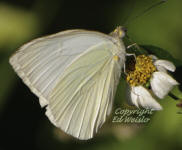
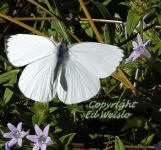
Upper surface of male forewing white with black zigzag pattern on outer margin. Dry season female form resembles male with the black zigzag pattern and a small black spot on the wing cell. Wet-season female darker.
The Great Southern White's larval host plants are Peppergrass, Mustards (Brassica spp.), Saltwort, and Sea Rocket. Habitat includes coastal areas - Salt marshes, dunes and coastal scrub. Flights are year round in South Florida, summer in the northern part of the state. Adult Great Southern Whites drink nectar from many flowers including Saltwort, Lantana and Verbenas.
White Peacock - Anartia jatrophae

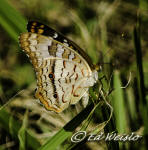
White dorsal (upper) surface with varying shades of brown markings, a double row of yellowish to orange-brown crescents along the outer and trailing edges of both wings. Forewing has one round, black spot, hindwing has two. The winter form is larger and paler, the summer form is smaller with darker colors.
Larval host plants include Water hyssop, Frogfruit, Verbena, and wild petunias. Adults use Sheppard's needles as a nectar source. Flights throughout the year in S. Florida, the White Peacock likes moist, open areas.
Long-tailed Skipper - Urbanus proteus
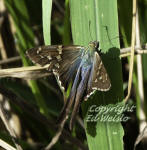
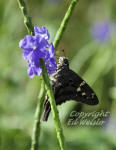
As the name implies, Long-tailed Skippers have long tails, they are brownish-black on the dorsal side with an iridescent blue-green body and wing bases, forewings have a band of lighter spots. Hindwing has a continuous brown band on the ventral edge. Adult wingspan is about 2 inches.
The Long-tailed Skippers have 3 or 4 generations per year and are common in Florida, as large numbers of this butterfly migrate from the southeast and Atlantic coastal states to the Florida peninsula every fall to overwinter here, returning northward with the arrival of warmer weather.
Larva have no hairs or spines, are light green with a black dorsal line, a yellow lengthwise stripe and black head with reddish patches. Larval host plants include various members of the Pea family (Fabaceae).
Adults feed on nectar from a variety of plants including Bougainvillea, Lantana, and Shepherd's needle.
Mangrove Skipper - Phocides pigmalion
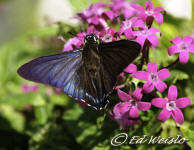
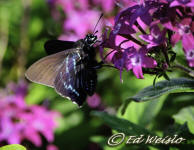
This butterfly inhabits Red Mangrove (Rhizophora mangle) thickets on both the east and west coasts of the Florida peninsula. The Red Mangrove tree is the sole caterpillar host plant, adults feed on the nectar from a variety of plants including Mangroves, Shepherd's needle, and citrus trees.
Wing span is 1 7/8" - 2 3/4", wings are dark brownish-black with iridescent blue scaling/ streaks above and below, hindwing with a submarginal row of light blue spots. Head has white face. Fast, powerful flight - stopping often to feed, often perches on the underside of leaves.
Caterpillar is deep red with bright yellow-orange bands, during last instar larva color changes to a creamy white, larva makes shelters by binding leaves together with silk. Flights from November to August in central and south Florida.
Tropical Checkered-Skipper - Pyrgus communis
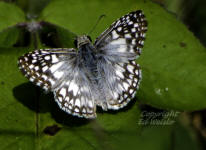
Tropical Checkered Skippers can be found throughout the Florida peninsula and Gulf states down through Texas to South America, they like open areas with a little bare ground and low growing vegetation. There may be as many as 5 broods annually, adults feed from the flowers of Sidas.
Dorsal side of males is bluish-gray, female is black, ventral side is off-white with gray to olive green bands. Both sexes have white spots forming median bands across both wings. Checkering is variable.
Atala - Eumaeus atala florida
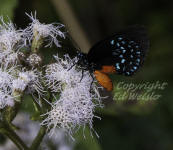
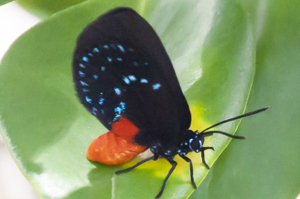
This small butterfly, with a wingspan of 1 1/2 to just under 2 inches is rare and considered endangered within Florida.
The Atalas range also includes the Bahamas and Cuba. Wings are black with iridescent blue-green scaling, bright red, orange-red spot on hindwing and orange abdomen.
Larval host plant is the Coontie (Zamia pumila), a native Florida cycad. Several flights occur throughout the year in South Florida, adults feed on Lantana, Sheppards needle and Wild Coffee.
Habitat types include shady tropical Hammocks and surrounding areas, areas planted with Cycads in Miami-Dade, Broward, Palm Beach, Martin and Monroe counties.
Ruddy Daggerwing - Marpesia petreus
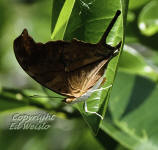
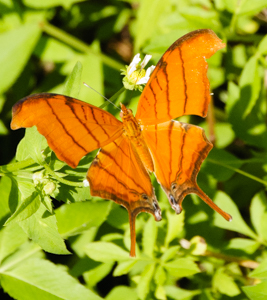
Resembling a dead leaf when its wings are folded, the Ruddy Daggerwing butterfly even has long "daggers" at the back of the hindwing that look like the stem of a leaf. Upperside is orange with three black lines on each wing.
This butterfly is found in hardwood hammocks and forests, the Florida native Ficus citrifolia, a type of Banyan and the cultivated Common fig are larval host plants.
Ruddy daggerwings are a large butterfly with a wingspan of 3 3/4 inches, adults feed on the nectar of the Giant milkweed, Lantana, Geiger tree(Cordia species) and others. Males will perch high on a tree and wait for females to fly below them.
Found year round in S. Florida the Ruddy daggerwing is most common from May through July.
Grey Hairstreak - Strymon melinus
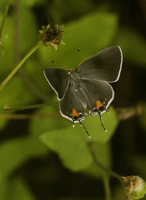
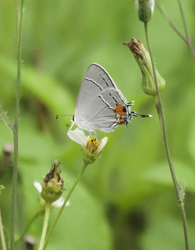
Gray hairstreaks are one of the most common of the hairstreak butterflies in North America, range also includes Central America as well as the northern edge of South America.
Blue-grey on top grey to paler grey on undersides with a large red spot on hindwing near tail. In the afternoon, males perch on shrubs and low growing trees to attract mates. Typically perches with its head down, showing off the red "eye" spot and tail that resemble a head and antennae thus escaping predators such as jumping spiders that attack the wrong end!
Prefered host plants are members of the pea and mallow families although many other plants are also used. Eggs are laid singly on the flowers of the host plant, young feed mainly on the flowers and fruit. Adults necter at many plants including milkweed, mints and goldenrod.
Common Buckeye - Junonia coenia
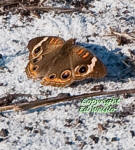
The Common Buckeye is brown on the dorsal side, the forewing has 2 orange bars and 2 eyespots, hindwing has 2 eyespots, the larger of the 2 has a magenta colored crescent shape within. Wing span is from 1 1/2 to just under 3 inches.
Host plants include Snapdragons, Toadflax and Plantains. Flights are produced throughout the year in Florida.
The Common Buckeye can be found in open, sunny areas like fields and pastures, adults often perch on low vegetation or bare ground.
Pearl Crescent - Phyciodes tharos

With 3-4 flights per year in Florida this butterfly can often be seen in open areas such as pastures, fields and the margins of woodlands. Variable in appearance, 1 1/4 to 1 3/4 inch wingspan, dorsal surface of wings is orange with black margins and crossed with black marks, underside of hindwing has a darker marginal patch with a pale (pearl) cresent.
Members of the Aster family are used as larval host plants, adults also feed on the nectar of asters.